Abstract
Two Rhodococcus strains which were isolated from a trichloroethylene (TCE)-degrading bacterial mixture and Rhodococcus rhodochrous ATCC 21197 mineralized vinyl chloride (VC) and TCE. Greater than 99.9% of a 1-mg/liter concentration of VC was degraded by cell suspensions. [1,2-14C]VC was degraded by cell suspensions, with the production of greater than 66% 14CO2 and 20% 14C-aqueous phase products and incorporation of 10% of the 14C into the biomass. Cultures that utilized propane as a substrate were able to mineralize greater than 28% of [1,2-14C]TCE to 14CO2, with approximately 40% appearing in 14C-aqueous phase products and another 10% of 14C incorporated into the biomass. VC degradation was oxygen dependent and occurred at a pH range of 5 to 10 and temperatures of 4 to 35°C. Cell suspensions degraded up to 5 mg of TCE per liter and up to 40 mg of VC per liter. Propane competitively inhibited TCE degradation. Resting cell suspensions also degraded other chlorinated aliphatic hydrocarbons, such as chloroform, 1,1-dichloroethylene, and 1,1,1-trichloroethane. The isolates degraded a mixture of aromatic and chlorinated aliphatic solvents and utilized benzene, toluene, sodium benzoate, naphthalene, biphenyl, and n-alkanes ranging in size from propane to hexadecane as carbon and energy sources. The environmental isolates appeared more catabolically versatile than R. rhodochrous ATCC 21197. The data report that environmental isolates of Rhodococcus species and R. rhodochrous ATCC 21197 have the potential to degrade TCE and VC in addition to a variety of aromatic and chlorinated aliphatic compounds either individually or in mixtures.
Full text
PDF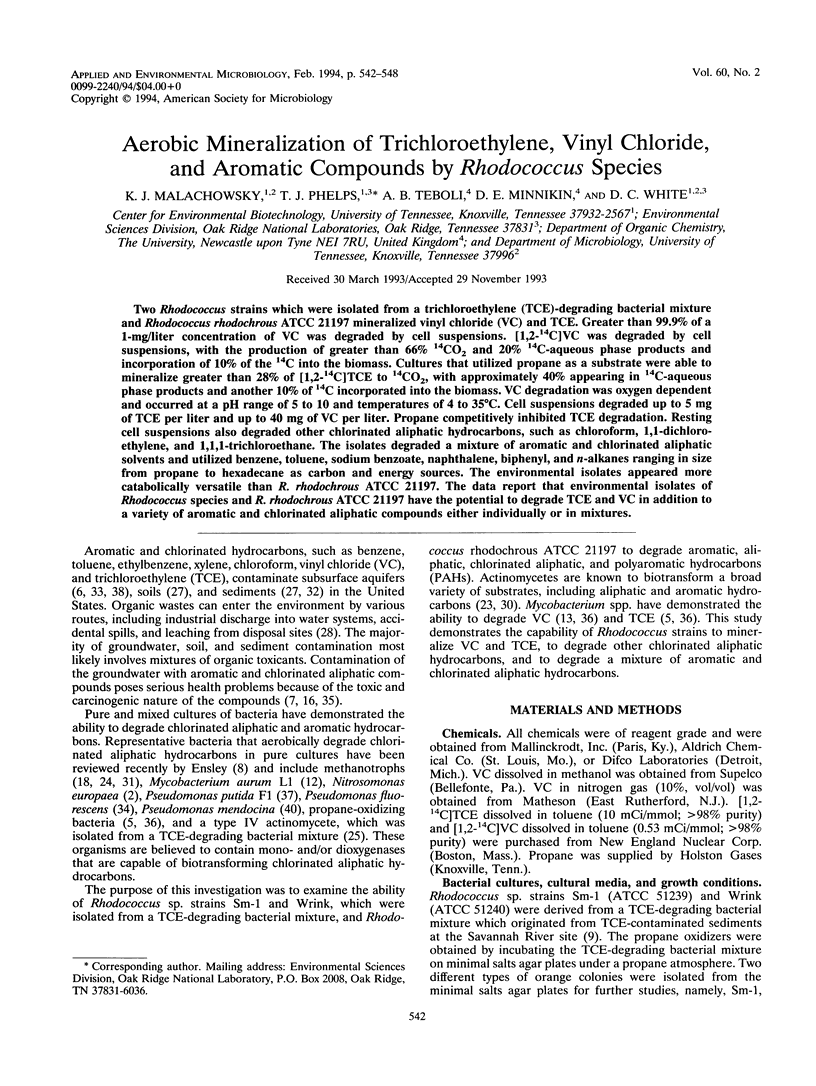
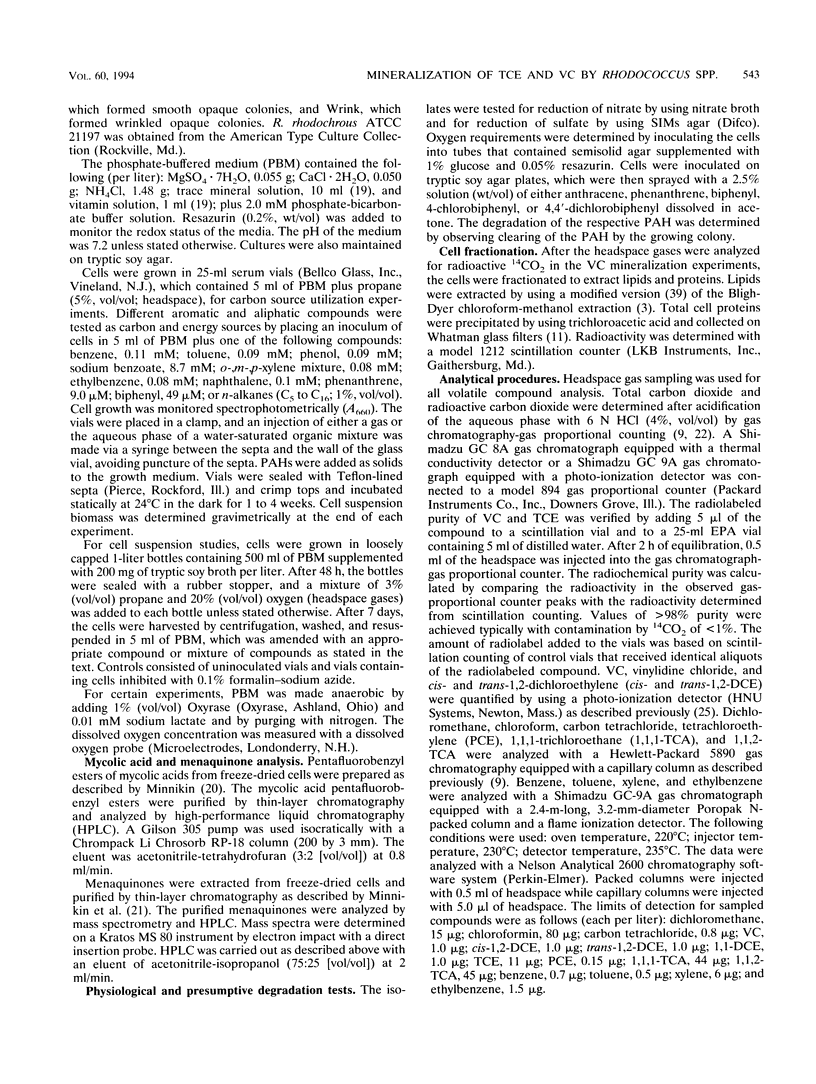
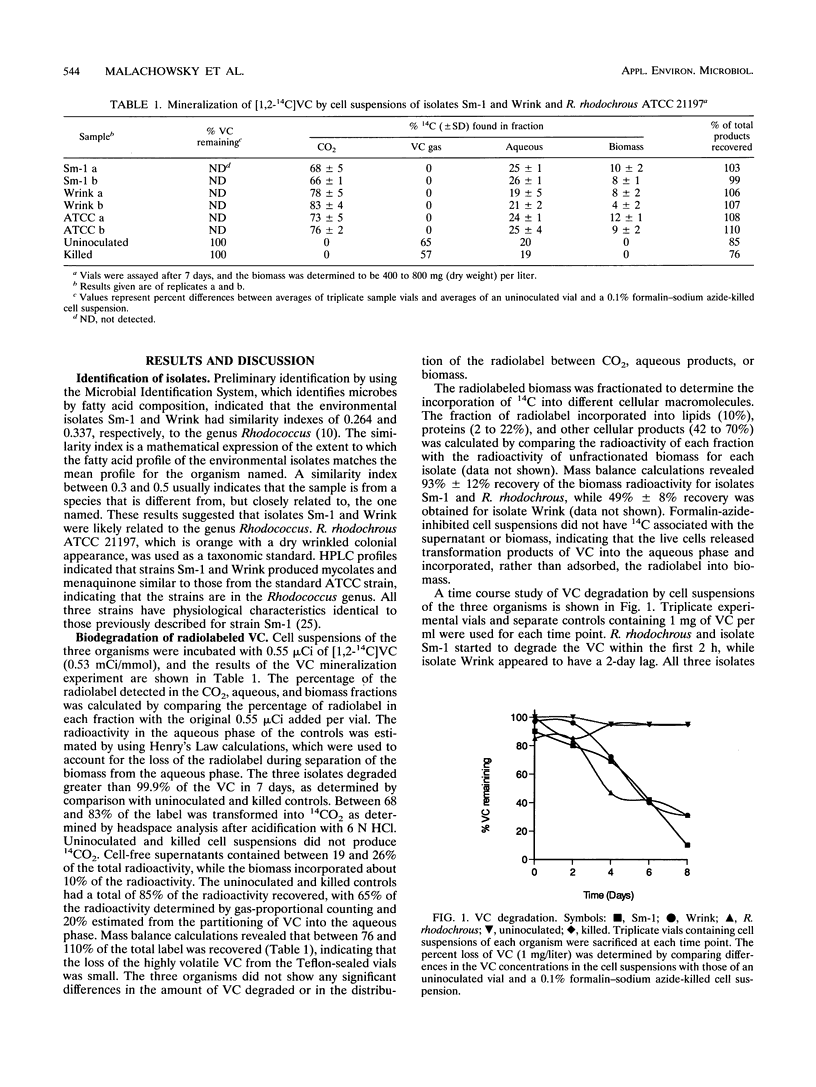
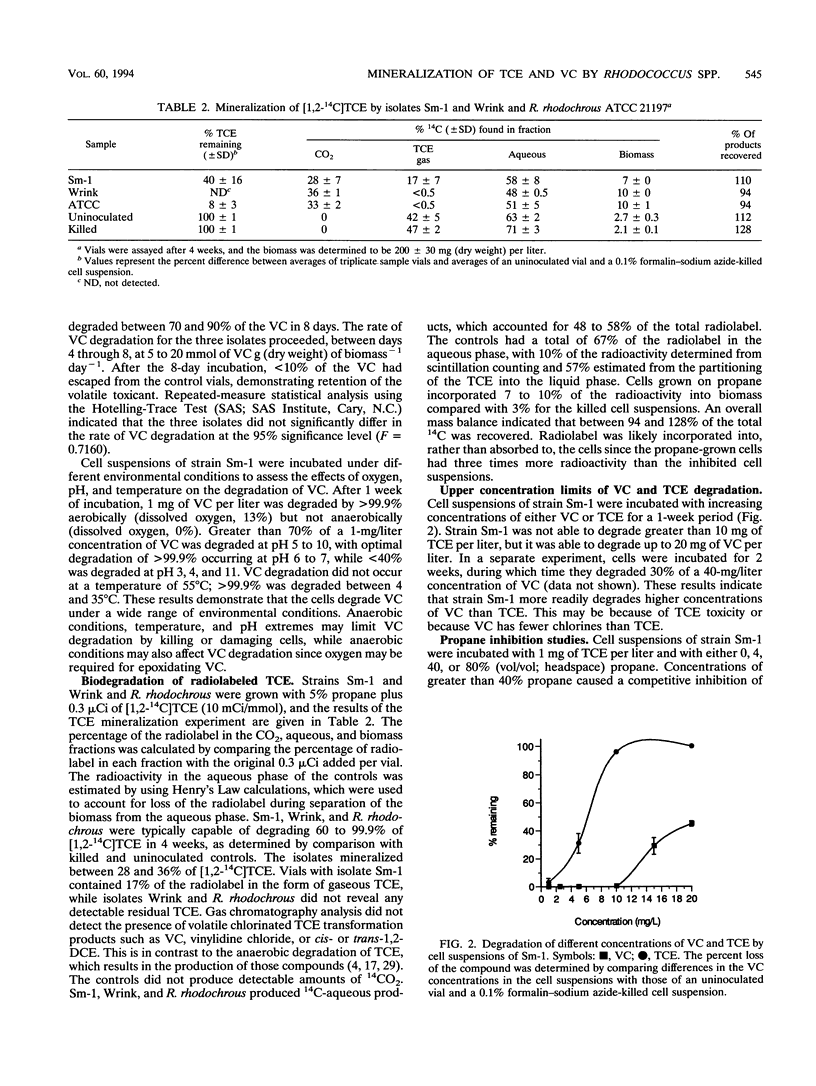
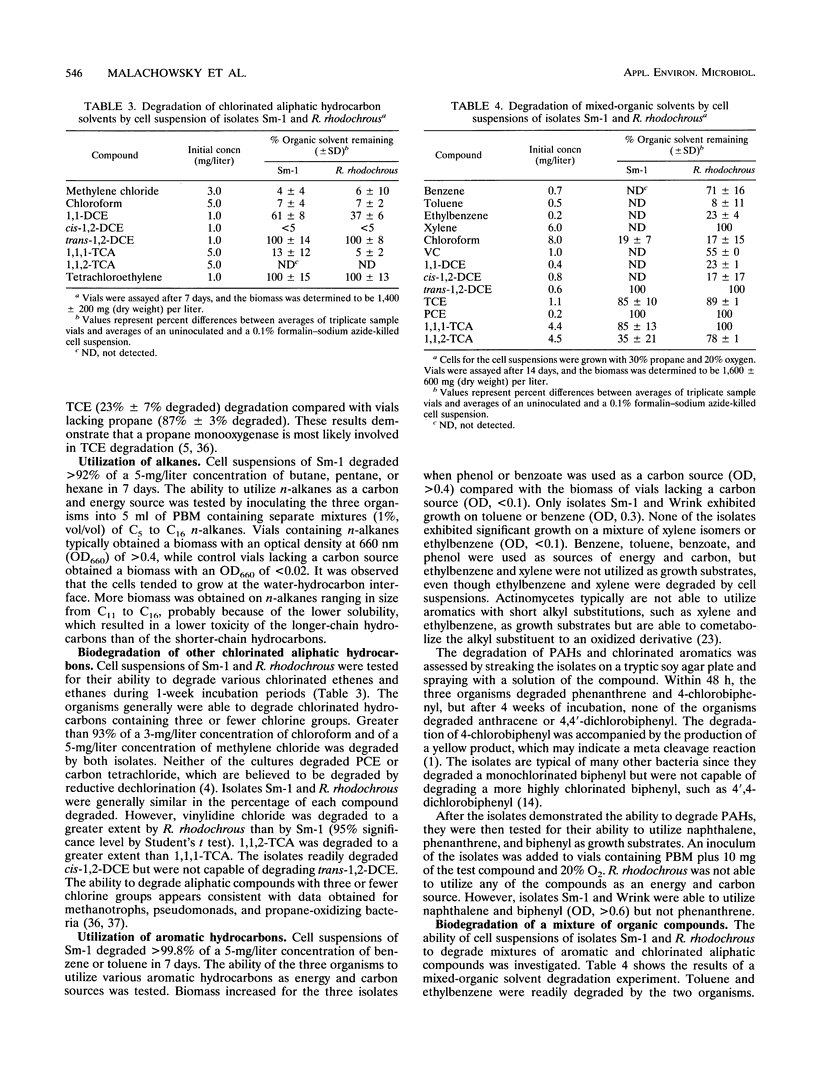
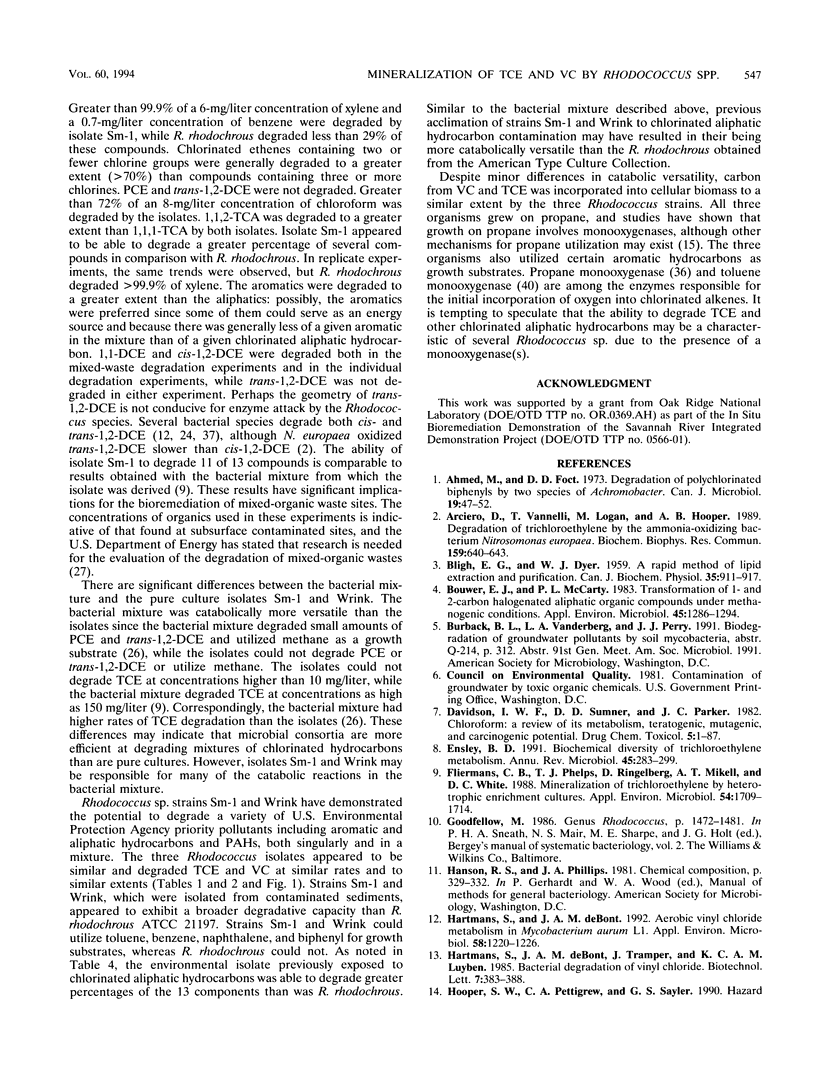
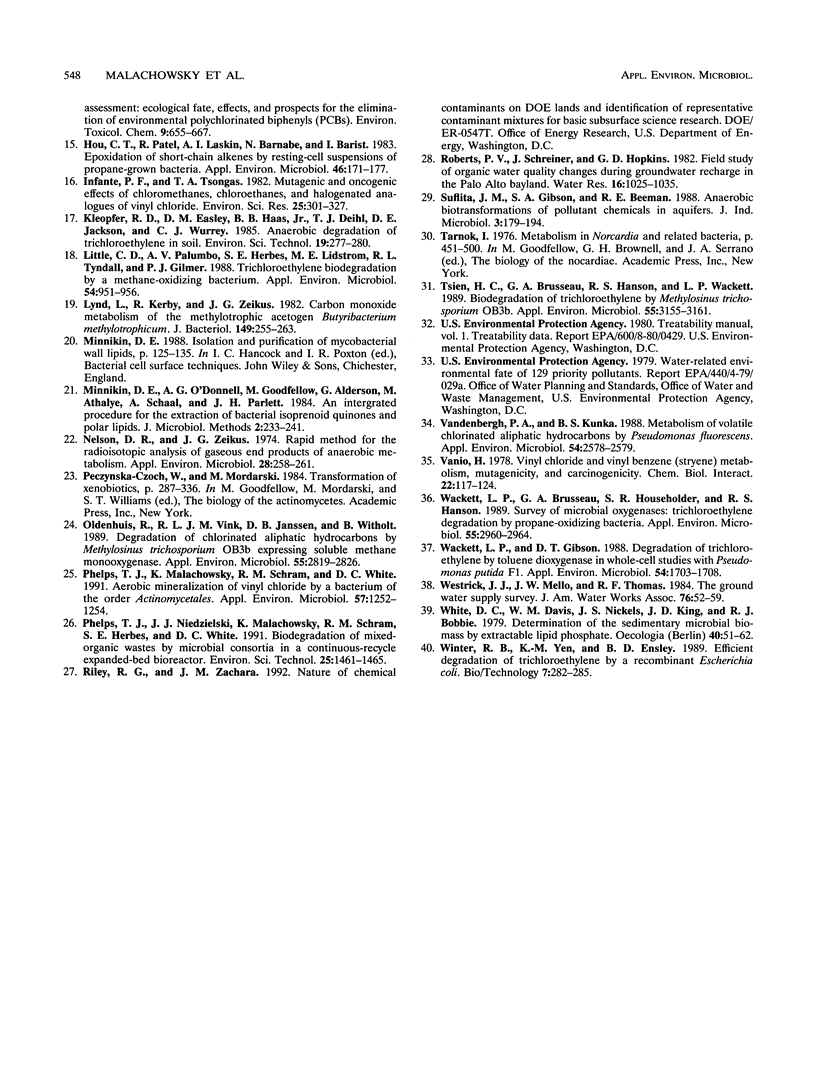
Selected References
These references are in PubMed. This may not be the complete list of references from this article.
- Ahmed M., Focht D. D. Degradation of polychlorinated biphenyls by two species of Achromobacter. Can J Microbiol. 1973 Jan;19(1):47–52. doi: 10.1139/m73-007. [DOI] [PubMed] [Google Scholar]
- Arciero D., Vannelli T., Logan M., Hooper A. B. Degradation of trichloroethylene by the ammonia-oxidizing bacterium Nitrosomonas europaea. Biochem Biophys Res Commun. 1989 Mar 15;159(2):640–643. doi: 10.1016/0006-291x(89)90042-9. [DOI] [PubMed] [Google Scholar]
- BLIGH E. G., DYER W. J. A rapid method of total lipid extraction and purification. Can J Biochem Physiol. 1959 Aug;37(8):911–917. doi: 10.1139/o59-099. [DOI] [PubMed] [Google Scholar]
- Bouwer E. J., McCarty P. L. Transformations of 1- and 2-carbon halogenated aliphatic organic compounds under methanogenic conditions. Appl Environ Microbiol. 1983 Apr;45(4):1286–1294. doi: 10.1128/aem.45.4.1286-1294.1983. [DOI] [PMC free article] [PubMed] [Google Scholar]
- Davidson I. W., Sumner D. D., Parker J. C. Chloroform: a review of its metabolism, teratogenic, mutagenic, and carcinogenic potential. Drug Chem Toxicol. 1982;5(1):1–87. doi: 10.3109/01480548209017822. [DOI] [PubMed] [Google Scholar]
- Ensley B. D. Biochemical diversity of trichloroethylene metabolism. Annu Rev Microbiol. 1991;45:283–299. doi: 10.1146/annurev.mi.45.100191.001435. [DOI] [PubMed] [Google Scholar]
- Fliermans C. B., Phelps T. J., Ringelberg D., Mikell A. T., White D. C. Mineralization of trichloroethylene by heterotrophic enrichment cultures. Appl Environ Microbiol. 1988 Jul;54(7):1709–1714. doi: 10.2172/666263. [DOI] [PMC free article] [PubMed] [Google Scholar]
- Hartmans S., De Bont J. A. Aerobic vinyl chloride metabolism in Mycobacterium aurum L1. Appl Environ Microbiol. 1992 Apr;58(4):1220–1226. doi: 10.1128/aem.58.4.1220-1226.1992. [DOI] [PMC free article] [PubMed] [Google Scholar]
- Hou C. T., Patel R., Laskin A. I., Barnabe N., Barist I. Epoxidation of short-chain alkenes by resting-cell suspensions of propane-grown bacteria. Appl Environ Microbiol. 1983 Jul;46(1):171–177. doi: 10.1128/aem.46.1.171-177.1983. [DOI] [PMC free article] [PubMed] [Google Scholar]
- Little C. D., Palumbo A. V., Herbes S. E., Lidstrom M. E., Tyndall R. L., Gilmer P. J. Trichloroethylene biodegradation by a methane-oxidizing bacterium. Appl Environ Microbiol. 1988 Apr;54(4):951–956. doi: 10.1128/aem.54.4.951-956.1988. [DOI] [PMC free article] [PubMed] [Google Scholar]
- Lynd L., Kerby R., Zeikus J. G. Carbon monoxide metabolism of the methylotrophic acidogen Butyribacterium methylotrophicum. J Bacteriol. 1982 Jan;149(1):255–263. doi: 10.1128/jb.149.1.255-263.1982. [DOI] [PMC free article] [PubMed] [Google Scholar]
- Nelson D. R., Zeikus J. G. Rapid method for the radioisotopic analysis of gaseous end products of anaerobic metabolism. Appl Microbiol. 1974 Aug;28(2):258–261. doi: 10.1128/am.28.2.258-261.1974. [DOI] [PMC free article] [PubMed] [Google Scholar]
- Oldenhuis R., Vink R. L., Janssen D. B., Witholt B. Degradation of chlorinated aliphatic hydrocarbons by Methylosinus trichosporium OB3b expressing soluble methane monooxygenase. Appl Environ Microbiol. 1989 Nov;55(11):2819–2826. doi: 10.1128/aem.55.11.2819-2826.1989. [DOI] [PMC free article] [PubMed] [Google Scholar]
- Phelps T. J., Malachowsky K., Schram R. M., White D. C. Aerobic mineralization of vinyl chloride by a bacterium of the order Actinomycetales. Appl Environ Microbiol. 1991 Apr;57(4):1252–1254. doi: 10.1128/aem.57.4.1252-1254.1991. [DOI] [PMC free article] [PubMed] [Google Scholar]
- Tsien H. C., Brusseau G. A., Hanson R. S., Waclett L. P. Biodegradation of trichloroethylene by Methylosinus trichosporium OB3b. Appl Environ Microbiol. 1989 Dec;55(12):3155–3161. doi: 10.1128/aem.55.12.3155-3161.1989. [DOI] [PMC free article] [PubMed] [Google Scholar]
- Vainio H. Vinyl chloride and vinyl benzene (styrene)--metabolism, mutagenicity and carcinogenicity. Chem Biol Interact. 1978 Jul;22(1):117–124. doi: 10.1016/0009-2797(78)90155-2. [DOI] [PubMed] [Google Scholar]
- Vandenbergh P. A., Kunka B. S. Metabolism of volatile chlorinated aliphatic hydrocarbons by Pseudomonas fluorescens. Appl Environ Microbiol. 1988 Oct;54(10):2578–2579. doi: 10.1128/aem.54.10.2578-2579.1988. [DOI] [PMC free article] [PubMed] [Google Scholar]
- Wackett L. P., Brusseau G. A., Householder S. R., Hanson R. S. Survey of microbial oxygenases: trichloroethylene degradation by propane-oxidizing bacteria. Appl Environ Microbiol. 1989 Nov;55(11):2960–2964. doi: 10.1128/aem.55.11.2960-2964.1989. [DOI] [PMC free article] [PubMed] [Google Scholar]
- Wackett L. P., Gibson D. T. Degradation of trichloroethylene by toluene dioxygenase in whole-cell studies with Pseudomonas putida F1. Appl Environ Microbiol. 1988 Jul;54(7):1703–1708. doi: 10.1128/aem.54.7.1703-1708.1988. [DOI] [PMC free article] [PubMed] [Google Scholar]


